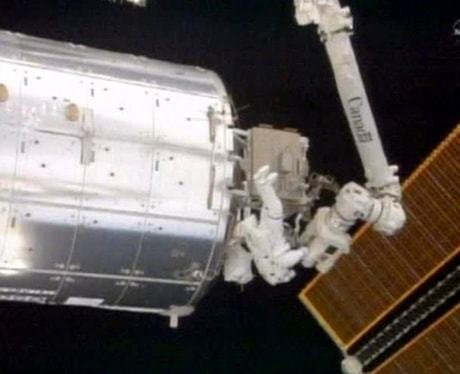CAPE CANAVERAL, Fla. — The 220-mile-high (355-kilometre-high) unveiling of R2, the first humanoid robot in space, is being moved up at the urging of the president of the United States.
Astronaut Catherine Coleman said Friday that she and the 11 other humans aboard the shuttle-station complex want to get R2 out of its packing material as soon as possible.
“We’ve all been voting to move up getting him out of his box,” she said during a crew news conference. “In fact, we’re all pretty sure that we hear scratching from the inside there.”
Robonaut 2, better known as R2, flew to the International Space Station aboard Discovery. In a phone call to the two crews Thursday, President Barack Obama teased the astronauts for waiting to unpack the robot.
NASA managers initially were going to wait a couple of months before getting R2 out. But the fact that Discovery is spending two extra days at the orbiting outpost, so its crew can help unpack a newly installed storage unit, has sped everything up.
Coleman said she’s not sure if the astronauts will be able to get R2 out before Discovery leaves Monday.
In any event, Coleman, both a scientist and engineer, said she can’t wait to test Robonaut during the remainder of her space station stay. As robots travel into space, it’s important to learn how they operate in weightlessness, she said. Better to learn those lessons inside the space station, before a robot ventures out on a spacewalk or roams other planets, she added.
It will take both humans and robots “to get us further out into the universe, and Robonaut is a good first step,” Coleman said.
R2 — lacking legs and built from the waist up — will undergo a series of tests before tackling simple space station chores at its permanent home.
This is Discovery’s final voyage. It’s being retired once it returns to Earth on Wednesday, 13 days after blasting off, and will be sent to the Smithsonian Institution for display.
NASA Administrator Charles Bolden will announce the final resting places for the two other space shuttles on April 12, the 30th anniversary of the first shuttle flight. More than 20 museums and educational institutions across the country, including the Kennedy Space Center Visitor Complex, are vying for display rights. Enterprise, a test vehicle that never made it to space, is also up for dibs.
As for Discovery — NASA’s oldest and most travelled shuttle — commander Steven Lindsey said he and his crew have been too busy to focus on the historic aspect. But every so often, he reflects on the fact that Discovery will never fly again.
“What a great vehicle it’s been, 39 missions, nearly one year on orbit,” Lindsey said. “It’s just really inspiring to me and kind of bittersweet and quite frankly sad, knowing that when we land, that will be it for this vehicle.”
Astronaut Alvin Drew said it was poignant to see the shuttle filling his entire visor during his two spacewalks.
“It’s just a magnificent ship ... to be out there working on, around and near it, is just a privilege to be part of the legacy of Discovery. Seems like a blessing,” Drew said.
The astronaut who went spacewalking with Drew earlier this week, Stephen Bowen, said he’s still pinching himself to see if he’s dreaming. He joined Discovery’s last crew last month, replacing astronaut Timothy Kopra, who injured himself in a bicycle accident.
“There’s no possible way I can make it up to Tim,” Bowen said with a smile. “If there’s anything I can do for him, I’m willing to discuss it.”
———
Online:
NASA: http://www.nasa.gov/mission—pages/shuttle/main/index.html
